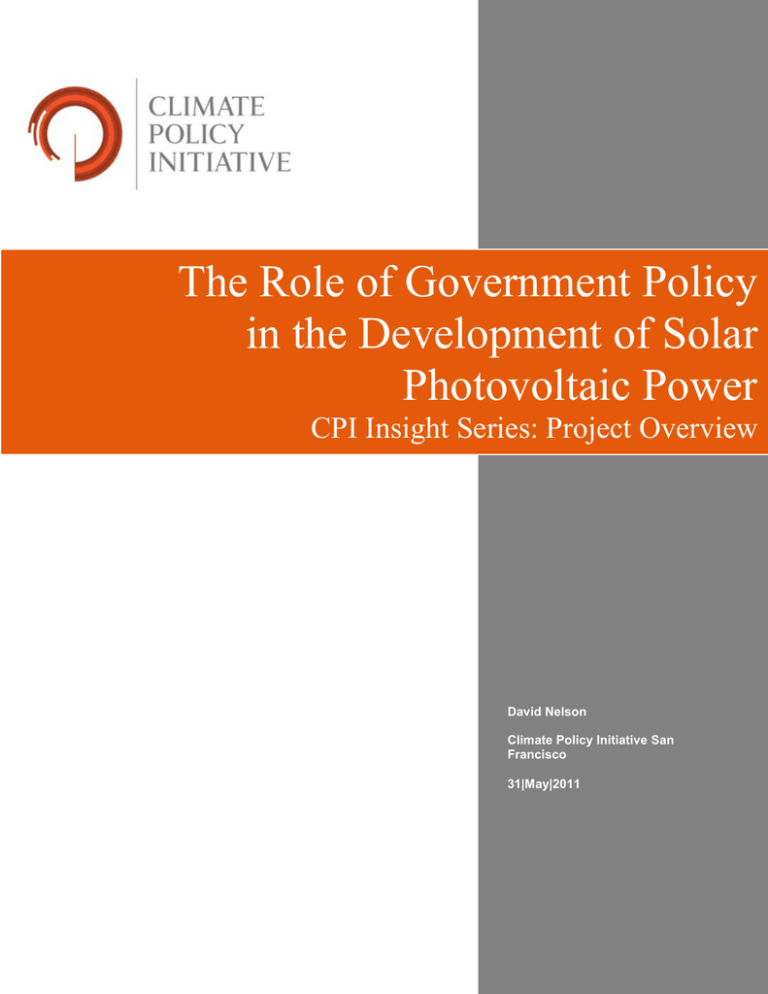
The Role of Government Policy
in the Development of Solar
Photovoltaic Power
CPI Insight Series: Project Overview
David Nelson
Climate Policy Initiative San
Francisco
31|May|2011
Descriptors
Sector
Region
Keywords
Power and Energy,
Innovation, Removing
Barriers/Complementary
Policies
United States, China, Europe
Solar PV, Policy
About CPI
Climate Policy Initiative (CPI) is a policy effectiveness analysis and advisory organization whose
mission is to assess, diagnose, and support the efforts of key governments around the world to
achieve low-carbon growth.
CPI is headquartered in San Francisco and has offices around the world, which are affiliated with
distinguished research institutions. Offices include: CPI at Tsinghua, affiliated with the School of Public
Policy and Management at Tsinghua University; CPI Berlin, affiliated with the Department for Energy,
Transportation, and the Environment at DIW Berlin; CPI Rio, affiliated with Pontifical Catholic
University of Rio (PUC-Rio); and CPI Venice, affiliated with Fondazione Eni Enrico Mattei (FEEM). CPI
is an independent, not-for-profit organization that receives long-term funding from George Soros.
© Climate Policy Initiative, 2011
All rights reserved
The Role of Government Policy in the Development of Solar Photovoltaic Power
May 2011
In late 2010, CPI began a study of the impact
of national and international policy on the
development of Solar Photovoltaic (PV)
technology. A full report, including regionspecific analysis, is expected this summer.
Project Motivations
In late 2010, CPI began a study of the impact of national and international policy on the development of
Solar Photovoltaic (PV) technology. A full report, including region-specific analysis, is expected this
summer.
CPI selected Solar PV as one of its first global analytic efforts for a number of reasons:
•
•
•
•
•
The technical potential of PV is large enough to make a significant contribution to greenhouse
1
gas mitigation goals.
PV costs have decreased substantially, in part as a direct and indirect result of government
policies.
PV costs must come down further to become cost competitive with conventional energy sources,
2
a major step toward reaching PV’s potential.
There is substantial global experience with PV policy, as numerous countries have used diverse
policy approaches with varied success.
Solar PV is representative of the many technologies relevant to climate and energy that still
require research, innovation, and market deployment.
CPI’s focus in this project has been on the effectiveness of policy in helping PV reach its technical
potential. More specifically, the focus has been the impact of policy in driving down the cost of energy
from PV, as cost is the single most important obstacle standing in the way of PV’s potential. In this project
overview, we address several of the major questions that policymakers face in their effort to make PV
more cost competitive. We then set out the framework under which we have begun to analyze these
questions.
1
The CPI report “Assessment of Photovoltaic Technology Policy in Germany and China” (November
2010), estimates the technical potential of PV. For example, using only the building integrated systems, it
estimates that around 30% of electricity in both China and Germany could be generated from solar.
Including solar parks more than doubles this number. In a different approach, the McKinsey study,
“Pathways to a Low Carbon Economy” suggests that approximately 4% of the greenhouse gas savings
required between now and 2030 to meet the 2 degrees C path could be achieved through Solar PV.
2
The November CPI report argues that costs must fall 50% to 70% more for PV to be economically
competitive in general applications.
CPI Insight Series: Project Overview
Page 3
The Role of Government Policy in the Development of Solar Photovoltaic Power
1
May 2011
The Major Policy Questions
With the role of policy in PV cost reduction in mind, we have identified several major questions that policy
makers will face and which our work will address. Some of these include:
1. How effective have current and past PV policies been and why?
3
Policy effectiveness lies at the heart of CPI policy evaluation. The organization’s approach is
to use data-based analysis of policies to identify policy design and implementation issues that
have led to the success or failure of a policy. Our approach to assessing policy effectiveness
looks beyond simple measures of abatement per dollar spent to incorporate concepts such
as the timing of abatement, treatment of risk and uncertainty, and measuring both the direct
impact of a policy on emissions versus the impact of a policy in making other policies more
effective.
2. Have targeted or broad based policies been more effective?
A well-structured, broad-based policy (e.g., a carbon price) could allow technology or project
developers access to the widest range of potential tools to achieve their mitigation objective.
Targeted tools (e.g., a specific research grant) could focus on one particular obstacle to
technological advancement. In many cases, a mix of policies could be appropriate. Our aim
is to analyze the specifics of the PV industry and relevant policy so far and draw lessons
about what types of policies work and how.
3. How effective have PV policies been in achieving multiple objectives, including nonenergy or climate related objectives?
PV policy in China and Germany has pursued twin goals of national industrial development
and progress on clean technology. The perceived success of these policies could depend
4
upon which lens is used for evaluation. The primary focus of this study is on developing
clean technology and reducing its cost. However, understanding this dimension of policy
effectiveness will help us draw insights as to the cost and effectiveness of the policy with
respect to the additional objectives and the cost of combining objectives.
4. At what geographic level should policies be set and how do local and national polices
interact on a global scale?
Participants in the PV industry, as well as the activities, businesses, and projects they
undertake, may be national, global, or local. A PV unit installation might be a very local
issue, for instance, while poly-silicon production or wafer manufacturing may be designed for
the global market. As a result, local policies could interfere with (or complement) national
policies, and the national policies of various countries could interact with each other.
3
CPI’s general approach to policy effectiveness will be laid out in a separate paper.
CPI Insight Series: Project Overview
Page 4
The Role of Government Policy in the Development of Solar Photovoltaic Power
May 2011
Understanding this dynamic is important to designing policies and coordinating policy
development.
5. How should policies be structured to facilitate effective use of the capital markets?
In general, the role of the capital markets become increasingly significant as technologies
near commercial deployment; as it is at this point where financing can make the difference
between a project succeeding or failing. Whether a project can be financed will depend upon
its risk/reward balance. For PV, the risks and rewards will be determined by among other
things, the geography, technology, activity, and policy. As in question 4, the impact of policy
on financing may be very different for a manufacturer that is building a factory for the global
market, than for a local rooftop installation.
CPI Insight Series: Project Overview
Page 5
The Role of Government Policy in the Development of Solar Photovoltaic Power
2
May 2011
Framework for Evaluating the Impact of Policies on the Long-term Costs
of Solar PV
Given the breadth of the PV sector and the issues discussed above, we propose to break down the
problem into its component parts - as defined by value chain segments - and then evaluate the impact of
policies on each of these segments. In this context, we will link the effectiveness of policy in achieving its
objectives through four steps (see Figure 1 on the following page):
•
•
•
•
Objectives - As described earlier, we begin with the objective of cost reduction.
Activities - We then look at the business activities that lead to technology development and
wide-scale deployment– including research, design, manufacture, development, installation,
and financing – and identify which of these could facilitate achievement of the desired
objective.
Drivers - For each of these activities, we look at the drivers or levers than can be used to
squeeze performance out of the activity, leading towards fulfillment of the objective.
Policies - Finally, we look at policies and assess their impact on the drivers.
With a better understanding of the components of the PV industry, we can begin to address each of the
policy questions above, including:
•
•
•
The effectiveness of relevant policies on each particular activity;
How well broad-based policies may have worked in creating opportunities to innovate
between segments, and where targeted policies have been successful;
Where – at a geographical and activity level – have policies interfered or complemented each
other.
Together, this understanding should enable policy makers to build cost effective policy sets.
CPI Insight Series: Project Overview
Page 6
Figure 1. Framework for Evaluating the Impact of Policies on the Long Term Costs of Solar PV
Objective
While the technology is large, the key to PV making a large impact is
cost reduction to make the technology competitive with alternatives
Drivers
• Learning by doing
• Economies of Scale
• Technological Breakthroughs
• Knowledge spillovers from other industries
• Market and technology de-risking
• Others
The costs of many emerging technologies have been shown to fall as a
function of the units cumulative production. This “experience curve”
principle has also been applied to renewable energy including wind and
Solar PV. Policy makers have surmised that making a technology
commercially viable requires a market large enough such that costs
come down to the appropriate level. While creating the market may be
directionally right, there are several reasons why larger markets might
lead to lower costs, with different policy implications.
Activities
Producing energy from Solar PV is a multistage process, each of which is
at a different level of development, commoditization and globalization.
When assessing the impact of policy on PV, one place to start is to
break PV into its value chain components and investigate the impact of
policy on that segment of the value chain and assess how much more
room for improvement there might be along that segment.
Policies
Feed in tariffs can have a strong impact on learning by doing and
economies of scale.
Understanding whether economies of scale are local or global and
whether the benefits are focused on the entire system or on one
particular element (for example wafer manufacture) may also
determine the effectiveness of the policy and the spillover effects.
Research grants might have a stronger impact on technology
breakthroughs, while certain designs of tax incentives could focus
support on more local issues, for example by encouraging the
development of project development, construction or installation skills..



